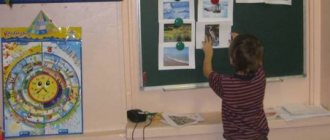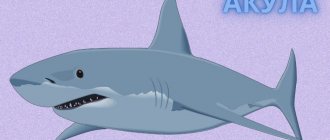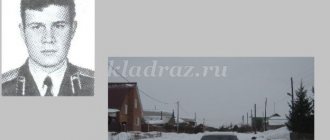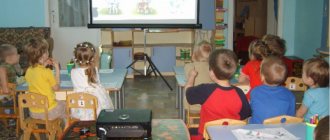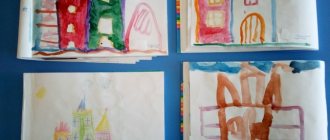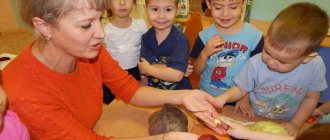Summary of educational activities for cognitive development with children of the preparatory group “Types of transport”
GCD in the preparatory group of a preschool educational institution.
Preparatory group Program objectives: 1. Develop knowledge about transport, its types 2. Develop children’s ability to distinguish between land, air and water transport.
3. Develop mental activity and attention. 5. Cultivate cognitive interest Progress:
Organizational moment. Guys, before we start our lesson, I want to invite you to solve riddles . 1. This horse does not eat oats, instead of legs there are two wheels. Sit on horseback and race on it, but it’s better to steer. (Bicycle) 2. A wonderful long house, There are many passengers in it. Wears shoes made of rubber And eats gasoline... (Bus) 3. Doesn't fly, but buzzes, A beetle runs down the street. And two brilliant lights burn in the beetle’s eyes. (Car) 4. Amazing carriage! Judge for yourself: The rails are in the air, and he holds them with his hands. (Trolleybus) 5. Well, my friend, guess, Only this is not a tram. A line of huts quickly rushes into the distance along the rails. (Train) 6. The giant lifts a lot of cargo to the clouds. Where he stands, then a new house grows. (Crane) 7. Without accelerating, it takes off high, Reminds me of a dragonfly, Sets off on a high-speed flight... (Helicopter) 8. Here is a steel bird, It strives for the skies, And its pilot leads it. What kind of bird? (Airplane) Well done, you guessed all the riddles. Now call it all in one word / Transport
Correctly, the topic of our lesson today is “Transport”
Conversation “Types of Transport” Transport can be different not only in appearance, but also in purpose, and also in the place of movement. What kind of transport do you think is called air transport? / Children's answers
Air transport is transport that moves through the air.
Name air transport / Plane, helicopter, parachute, airship, airplane, hot air balloon.
Air transport is the fastest mode of transport.
Air transport is mainly used for passenger transportation over distances of over a thousand kilometers. Freight transport is also carried out, but their share is very low. Most often, perishable products and especially valuable cargo, as well as mail, are transported by air. What kind of transport is called water transport? / Children's answers
Water transport is transport that moves on water. Name water transport. / Submarine, ship, kayak, boat, raft
Water transport is distinguished by its ability to transport very large loads.
Water transport is vital where land transportation is impossible: between continents, islands, and in poorly developed areas. The speed of water transport is relatively low, so at present it is almost never used for passenger transport. What kind of transport is called ground transport? / Children's answers
Ground transport is transport that moves on the ground. Name ground transport / Children's answers Ground transport is divided into different types of transport: trackless, road, railway
This is the most common type of transport. They use ground transport for various needs. For example, a passenger car for traveling short distances. Trains, trams, trolleybuses, electric trains are needed to transport passengers and are called public transport. Various dump trucks, trucks and Kamaz trucks are called freight transport, as they are used to transport goods. Motorcycles and bicycles are called two-wheelers and are used to travel around the area. There is also special transport, it is used by people of different professions. Such vehicles include an ambulance, a police car, a tractor, a fire truck, a garbage truck, a combine harvester, etc.
We got acquainted with different types of transport.
Now let’s see how well you can distinguish between air, water, and land transport. Didactic game "Fourth odd"
Great! Well done! Now I want to give you some homework. The teacher distributes road signs to the children.
For your next lesson, be prepared to talk about these road signs. The topic of our next lesson is “Road Safety”.
We recommend watching:
Summary of educational activities for cognitive development in the preparatory group "Journey to the North" Summary of educational activities in the preparatory group on the topic "Reservoirs" Summary of educational activities for cognition in the middle group on the topic "Transport" Summary of educational activities for speech development in the senior group on the topic: Transport
Similar articles:
Summary of a lesson in the preparatory group on the topic: Rules of conduct in kindergarten
Life safety lesson “Rules of safe behavior on water.” Preparatory group
Abstract of GCD in mathematics in the preparatory group. Counting to 11 and 12
Summary of mathematics lessons in the preparatory group. Number composition
Summary of mathematics lessons in the preparatory group. Adding and subtracting numbers
Transport quiz
Summary of educational activities on cognitive development in the preparatory group of a preschool educational institution in the form of a quiz.
Goal
: systematize children's knowledge about transport.
Tasks
:
- develop the ability to work in a team;
- carefully, quickly, accurately, responsibly;
- carry out a task, work according to the rule;
- continue to formulate methods of mental operations: analysis, comparison, generalization;
- consolidate children's knowledge of traffic rules.
Materials for the lesson
: paintings from the TV series “Transport”, crossword puzzle – 3 pieces, prizes, score sheets and pencils according to the number of jury members, team emblems for participants or costumes (motorists, pilots, sailors), three tables for teams, phone for the game “Dispatch room”, game “Puzzles” by type of transport – 3 pcs.
Preliminary work
: learning the outdoor game “Red, Yellow, Green”. Learning poetry. Getting to know crosswords, putting together puzzles. Preparation of emblems or costumes for teams. Inviting parents to the competition. Preparation of prizes for awards. Preparation of evaluation sheets for the jury, crossword puzzle sheets for teams.
Progress of the lesson
Presenter
: Hello, guys. Today I ask riddles:
1. What kind of miracle is this - a blue house, bright windows all around, wears rubber shoes, and eats gasoline? ( Car
.) 2. I don’t look like a horse, but I have a saddle.
( Bicycle, motorcycle
.) 3. Two brothers are running, and two are catching up.
( Car wheels
.) 4. I can only stay on the move, and if I get up, I’ll fall.
( Bicycle, motorcycle
.)
That's right, you guessed it! Dear guys, we talked a lot about transport, about traffic rules, about how to behave on the street, you have so much knowledge! And today we will hold a competition game on the topic “The best transport expert”! Let everyone see how great you are - both our jury and our mothers. To do this, we need to divide into 3 teams: “Motorists”, “Pilots”, “Seafarers”. ( I divide the children into teams, choose team captains. Each team is grouped around its own table. I set a goal: it is necessary to complete all the tasks and identify: who is the fastest in completing tasks, quick-witted and inquisitive
.)
Presenter
: The jury will watch our game and at the end of the game they will sum up the results. So, first task. Let's listen carefully to the question:
1) What is the name of a car, train, ship, plane, helicopter in one word? ( Transport
.) 2) Name water transport.
( Boat, steamship, boat, sailboat, liner
.) 3) Name the air transport.
( Airplane, helicopter, passenger plane, cargo plane, military plane.
)
Presenter
: Well done.
And now the game “Where is the car?” Connect the words in the sentence with a small word ( preposition
). Each team is asked two questions.
— The car has arrived _ in the garage — The car has left _ the garage — The car is moving _ in the garage — The car is moving over _ the bridge — The car has stopped _ in the garage — The car is moving off _ the bridge
Presenter
: Well done, we completed the tasks, and now we move on to the third task. Say in one word: “Who controls this type of transport?” Each team is asked two questions.
- Motorcycle - ... - Bicycle - ... - Motor ship - ... - Bus - ... - Tram - ... - Airplane - ...
Presenter
: Everyone is trying so hard, I’m sure the jury will appreciate your knowledge! Now come up with a sentence with supporting words:
1. Controller, bus, tickets, check. 2. Stop, there are a lot of people. 3. Light, road, red, no.
(A child reads S. Mikhalkov’s poems “Traffic Light”
.)
Presenter
: Who knows the traffic light rule?
The jury will add one point for a correct answer. ( Red – stop! Yellow – wait! Green – go!”
) And now we play the outdoor game “Red, yellow, green”.
( The leader of the game is a child. He has three flags - red, yellow and green. At the signal “Green flag!” children march in a circle, at the signal “Yellow flag!” they stand, at the signal “Red flag!” they squat down. Game repeated three times - the game leader changes
.)
Leading
: And now, let’s play the game “Dispatch”: “What kind of car do you need?”
Guys, tell me what car to call ( I call on the phone and pretend to have a telephone conversation with the dispatcher, the children tell me what car I need
).
- We urgently need a car to help a patient, we need to call... - To build a house we need... - We need to bring milk to the kindergarten, we need... - On the street a person is pestering passers-by, we need to call... - A country house is on fire, we need to call... - No cars can drive on the road because of the snow - they need...
Presenter
: The next task is “Crossword”.
You and I are familiar with crossword puzzles and know the rules: you need to write down the guessed words horizontally ( showing the direction with your hand
) and vertically (
showing the direction with your hand
).
Sit comfortably, take some pieces of paper with the crossword puzzle and listen carefully to the question. ( I give out one crossword puzzle for each table
.)
Horizontally:
1) What device helps you comply with traffic rules? ( Traffic light
.) 2) What is the name of the place where cars are parked after work?
( Garage
.)
Vertically:
1) What is the name of the place where people wait for transport? ( Stop
.) 2) What is the name of the pedestrian crossing?
( Zebra
.) 3) What is the name of that part of the streets where transport travels?
( Road
.)
Presenter
: So, the crossword puzzle is solved.
The respected jury evaluates the completion of the task, and we hold a “Captain Competition”. Make a picture out of puzzles and come up with a short descriptive story about the resulting mode of transport. ( Descriptive stories are heard
.)
Presenter
: Well, guys, today we remembered the types of transport.
We have all seen how well you know everything! How smart, inquisitive, and quick to answer you are, how well you can solve crosswords and make puzzles! Who will you tell about this? Who will you teach this knowledge to? Who can you tell about our quiz? I hope that you will always be as inquisitive in everything and will always follow the rules of the road, this is very, very important in life! Our game has come to an end, we give the floor to the jury. ( The jury sums up the quiz. The award ceremony takes place.
)
Aisylu Khasanova, teacher at MBDOU No. 64.
Nizhnekamsk, Republic of Tatarstan
Summary of a lesson on speech development in the preparatory group "Transport"
Tatyana Golubeva
Summary of a lesson on speech development in the preparatory group "Transport"
1. Expand and consolidate ideas about transport based on systematization and generalization of previously formed ideas. Clarify, expand and activate vocabulary on the topic;
2. Continue learning to compose complex sentences and form complex words. Make sentences from the words given in the initial position. Train in writing descriptive stories according to plan. Continue to teach children to conduct a sound analysis of a word, learn to calculate word stress and determine its place in a word.
2. Develop coherent speech , visual attention and perception, memory, thinking, speech hearing , coordination of speech with movement;
3. Develop skills of cooperation, mutual understanding, and goodwill.
Methods and techniques: visualization, didactic game, literary expression, conversation.
Equipment: pictures on the topic “ Transport ”
, sky, road, sea, word sound analysis table.
Preliminary work: general conversation about transport . Learning the exercise “On the Highway”
, finger game
"
Transport " , riddles and tongue twisters about
transport .

